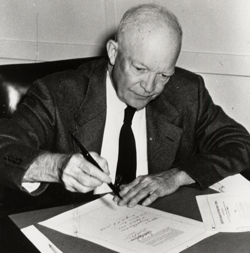Blame Ike for America’s Car Culture.
In January of 1956, I drove my first car, a 1951 Pontiac, from the University of Colorado in Boulder to my home near Hartford, Connecticut. I clearly remember driving most of those 2,000 miles on two-lane roads at 50 or 55 mile-an-hour speed limits and then, every hour or so, slowing way down to pass through the middle of towns—past grocery stores, pharmacies and inevitably a movie theater—before getting back onto the open highway. Looking back, I thoroughly enjoyed the experience. If you drove across the country in the mid-‘50s, you actually got to see something of America.

In 1956, the same year I made my cross-country automobile journey, President Dwight Eisenhower signed the Federal-Aid Highway Act of 1956 into law, thus creating our Interstate Highway System.
It was a massive public works project—in fact, I believe it’s still the biggest in this country’s history—and it allowed people to drive almost anywhere at much higher speeds without ever encountering a red light. Far more than that, it launched America’s car culture.
Say what you want about the U.S. of A., but we sure as hell know how to build roads. I just finished Asphalt Nation by Jane Holtz Kay. Its sub-title is How the Automobile Took Over America and How We Can Take It Back, and that tells you why you should read it. The book is now almost 20 years old, but it’s still dead on target and still available through Amazon.
And yet, despite all the choking traffic jams and the urban sprawl and the paving over of the landscape, it could be that we’re actually starting to get some of this figured out. For the first time ever, passenger rail was specifically named in a transportation bill passed by Congress. (Just ponder that for a moment.)
And the State of California’s Department of Transportation, known as Caltrans, has just released an report stating unequivocally that building more roads and highways won’t solve the congestion problem. Because they’re official, two of the report’s conclusions are startling, not to mention brave:
First, despite the claims, it’s not at all clear that big highway projects are a shot in the arm for local economies. In fact, much of the economic activity could well be the result of businesses relocating after being displaced by—you guessed it—the highway project.
And second, building new roads won’t reduce congestion, but will, in fact, create more congestion because more people are encouraged to start driving or to leave public transportation and go back to driving. In the trade it’s known as “induced demand”.
Eisenhower, by the way, considered the Interstate Highway System to be the crowning achievement of his administration. No doubt it was … then.


Interestingly, Eisenhower pushed Congress to publicly fund the construction-and maintenance-of the Interstate Highway System as a direct result of two experiences: the awesome design of the German Autobahn highways in WWII; the pathetic gravel roads of America traversed on a transcontinental army convoy post WWI.
Although initially a great boom for mobility and economic growth, nobody then realized the sociological damage these highways would create re urban plight, poverty zones, and exacerbation of segregation. From my research as a writer, I have concluded that the first “Solyndra” was not the solar panels of 2009-10. In reality, it was the Federal government’s overt interference by picking winners and losers within the same industry–transportation.
The Feds publicly funded interstates, FAA, Air Traffic Control Systems, and airports (munis). Now Greyhound could be time competitive and cheaper than “The Pacemaker;” trucks would eat the high value freight; airlines would takeover long hauls, and within 11years, also kill off the RPO, which helped to sustain passenger trains. How could the private railroads, taxed on every mile of track, depots, yards, etc., be expected to compete on such an un-level playing field supported by the open purse of the U.S.Treasury? You can only blame stagnant rail management (except Santa Fe and NYC) and shop raft unions for only so much, as compared to the massive Federal dollars invested–against rail, concomitant to the choking ICC regulatory environment.
Howver. we are finally coming around full circle to realize mistakes of the past, with forward looking states and regions embracing rail to create mobility and economic growth in key corridors. Like the Phoenix-bird, passenger trains are very much part of the planning–and growth–in CA, OR, WA, VA, NC, and even New England. What we need now is an enlightened Congress, supported by DOT, to understand that the unleveled playing field of the past cannot be tolerated now, given the imbalance of funding and political support for the Northeast Corridor, literally at the expense of the long distance routes and state corridors.
This will be a major requirement for the impending new CEO of Amtrak.